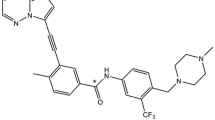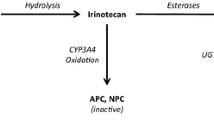Abstract
The bioequivalence of etoposide phosphate, a prodrug of etoposide, to etoposide was assessed in a randomized, crossover study in 29 patients with histologically established solid tumors that had failed conventional treatment. Cohorts of patients received one treatment course each of etoposide and etoposide phosphate which consisted of a 100 mg/m2 per day etoposide equivalent dose infused iv over 1 hr on a Day 1 to 5 schedule of treatment. The second course was administered 21 days later or on recovery of blood cell counts. Plasma and urine samples were collected over 24 hr on Day 1 of each course and assayed for etoposide content by a validated HPLC/UV method. Resulting data were subjected to noncompartmental pharmacokinetic analysis. Hematology profiles were obtained by collecting blood samples prior to the first course and twice a week after each course. The pharmacodynamics and pharmacokinetics of etoposide were virtually identical after the two treatments. The point estimates (90% confidence intervals) for nadir WBC, granulocytes, hemoglobin, and platelets expressed as % decrease from the baseline, and for the pharmacokinetic parameters, Cmax, and AUC0-∞, after intravenous etoposide phosphate relative to etoposide were 100% (96%, 105%), 97% (91%, 103%), 95% (82%, 109%), 95% (84%, 106%), 107% (101%, 113%), and 113% (107%, 119%), respectively. Therefore, etoposide phosphate is bioequivalent to etoposide based on pharmacokinetic and pharmacodynamic assessments.
Similar content being viewed by others
References
P. J. O'Dwyer, B. Leyland-Jones, M. T. Alonso, S. Marsoni, and R. E. Wittes. Etoposide (VP-16-213), Current status of an active anticancer drug.New Engl. J. Med. 312:692–699 (1985).
M. M. Hudson, H. J. Weinstein, S. S. Donaldson, C. Greenwald, L. Kun, N. J. Tarbell, W. A. Humphrey, C. Rupp, N. M. Marina, J. Wilimas, and M. P. Link. Acute hypersensitivity reactions to etoposide in a VEPA regimen for Hodgkin's disease.J. Clin. Oncol. 11:1080–1084 (1993).
C. A. Linker, C. A. Ries, L. E. Damon, H. S. Rugo, and J. L. Wolf. Autologous bone marrow transplantation for acute myeloid leukemia using busulfan plus etoposide as a preparative regimen.Blood 81:311–318 (1993).
A. M. Gianni, M. Bregni, S. Siena, M. Magni, M. De-Nicola, F. Lombardi, C. Tarella, A. Pileri, and G. Bonadonna. Granulocyte-macrophage colony stimulating factor or granulocyte colony-stimulating factor infusion makes high-dose etoposide a safe outpatient regimen that is effective in lymphoma and myeloma patients.J. Clin. Oncol. 10:1955–1962 (1992).
N. J. Chao, A. S. Stein, G. D. Long, R. S. Negrin, M. D. Amylon, R. M. Wong, S. J. Forman, and K. G. Blume. Busulfan/Etoposide-Initial experience with a new preparatory regimen for autologous bone marrow transplantation in patients with acute nonlymphoblastic leukemia.Blood 81:319–323 (1993).
T. L. Schwinghammer, M. Reilly, and C. S. Rosenfeld. Cracking of ABS plastic devices used to infuse undiluted etoposide injection [Letter].Am. J. Hosp. Pharm. 45:1277 (1988).
D. R. Budman, L. N. Igwemezie, S. Kaul, J. Behr, S. Lichtman, P. Schulman, V. Vinciguerra, S. L. Allen, J. Kolitz, K. Hock, K. O'Neill, L. Schacter, and R. H. Barbhaiya. Phase I evaluation of water-soluble etoposide prodrug, etoposide phosphate, given as a 5-minute infusion on days 1, 3, and 5 in patients with solid tumors.J. Clin. Oncol. 12:1902–1909 (1994).
L. N. Igwemezie, S. Kaul, and R. H. Barbhaiya. Assessment of toxicokinetics and toxicodynamics following intravenous administration of etoposide phosphate in beagle dogs.Pharm. Res. 12:117–123 (1994).
M. J. Milward, D. R. Newell, K. Balmanno, C. J. Charlton, L. Gumbrell, M. J. Lind, F. Chapman, M. Proctor, D. Simmonds, B. Cantwell, G. A. Taylor, C. McDaniel, B. Winograd, and A. H. Calvert. Clinical and pharmacokinetic study of BMY-40481. (Abstract).Proc. Am. Assoc. Cancer Res. 33:529 (1992).
S. Z. Fields, L. N. Igwemezie, S. Kaul, L. P. Schacter, R. J. Schilder, P. P. Litam, B. S. Himpler, C. McAleer, J. Wright, R. H. Barbhaiya, C. J. Langer, and P. O'Dwyer. Phase I study of etoposide phosphate (Etopophos) as a 30-min infusion on days 1, 3, and 5.Clin. Cancer Res. 1:105–111 (1995).
D. S. Thompson, F. A. Greco, A. A. Miller, N. R. Srinivas, L. N. Igwemezie, J. D. Hainsworth, L. P. Schacter, S. Kaul, R. H. Barbhaiya, G. C. Garrow, and K. D. Hande. A phase I study of etoposide phosphate administered as a daily 30-minute infusion for 5 days.Clin. Pharmacol. Ther. 57:499–507 (1995).
M. Gibaldi and D. Perrier.Pharmacokinetics, 2nd ed., Dekker, New York, 1982.
M. Weiss. A general model of metabolite kinetics following intravenous and oral administration of the parent drug.Biopharm. Drug Dispos. 9:159–176 (1988).
G. E. P. Box and D. R. Cox. Analysis of transformations.J. Roy. Stat. Soc. B. 26:211–252 (1964).
D. J. Schuirmann. A comparison of the two one-sided tests procedure and the power approach for assessing the equivalence of average bioavailability.J. Pharmacokin. Biopharm. 15:657–680 (1987).
V. W. Steinijans and D. Hauschke. International harmonization of regulatory bioequivalence requirements.Clin. Res. Reg. Affairs. 10:203–220 (1993).
SAS Institute.SAS User's Guide: Statistics Version 5.18, 5th ed., SAS Institute, Cary, NC, 1985.
B. P. McGrath, R. W. Watts, and D. B. Elmfeldt. Clinical equivalence of two tablet formulations of feldopine: A placebo controlled study of 24-hour blood pressure control and tolerability.Eur. J. Clin. Pharmacol. 49:169–172 (1995).
S. Kaul, L. N. Igwemezie, D. J. Stewart, S. Z. Fields, M. Kosty, N. Levithan, R. Bukowski, D. Gandara, G. Goss, P. O'Dwyer, L. P. Schacter, and R. H. Barbhaiya. Pharmacokinetics and bioequivalence of etoposide following intravenous administration of etoposide phosphate and etoposide in patients with solid tumors.J. Clin. Oncol. 13:2835–2841 (1995).
A. A. Miller, C. F. Stewart, and E. A. Trolley. Clinical pharmacodynamics of continuous infusion etoposide.Cancer Chemother. Pharmacol. 25:361–366 (1990).
C. F. Stewart, S. G. Arbuck, R. A. Fleming, and W. E. Evans. Relationship of systemic exposure to unbound etoposide and hematologic toxicity.Clin. Pharmacol. Ther. 50:385–393 (1991).
M. J. Milward, D. R. Newell, V. Mummaneni, L. N. Igwemezie, K. Balmanno, C. J. Charlton, L. Gumbrell, M. J. Lind, F. Chapman, M. Proctor, D. Simmonds, B. M. J. Cantwell, G. A. Taylor, C. McDaniel, B. Winograd, S. Kaul, R. H. Barbhaiya, and A. H. Calvert. Phase I and pharmacokinetic study of a water soluble etoposide prodrug, etoposide phosphate (BMY-40481).Eur. J. Cancer 13A:2409–2411 (1995).
Author information
Authors and Affiliations
Rights and permissions
About this article
Cite this article
Mummaneni, V., Kaul, S., Igwemezie, L.N. et al. Bioequivalence assessment of etoposide phosphate and etoposide using pharmacodynamic and traditional pharmacokinetic parameters. Journal of Pharmacokinetics and Biopharmaceutics 24, 313–325 (1996). https://doi.org/10.1007/BF02353515
Received:
Accepted:
Published:
Issue Date:
DOI: https://doi.org/10.1007/BF02353515




